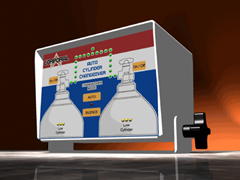Our clients come to us with unique, challenging problems to solve. Here are a few examples of diverse solutions we’ve designed.
Case Studies
The Problem
The Maricopa Association of Governors and the Phoenix Police Department required a simple method to synchronize their 911 logging recorders with a precise and accurate time source. Previously, the clock on each 911 call logger had to be updated using an expensive dedicated GPS clock with a serial output. The 911 call loggers had various inputs including serial communication (RS-485) allowing their real time clocks to be synchronized to the correct time.
In order to save money and reduce complexity, the Phoenix Police Department decided to use a single GPS clock and Network Time Protocol to synchronize the time stamps on every 911 call logger over their network. USDD was asked to design an interface between the RS-485 input of the 911 recorders and the NTP protocol used by the central GPS clock.
Our Solution
US Digital Designs analyzed the protocols used by both the 911 recorder and the network connection used by the Phoenix Police Department. USDD then developed the 911/NTP controller.
The 911/NTP interfaces with the Phoenix Police Department’s Intranet and obtains the correct time using NTP. It then compensates for delays due to network lag, serial communication timing and other factors as it delivers time stamps to the 911 call loggers. The time stamps are correct to within ten milliseconds.
The various operating parameters of the device are configured using an RS-232 interface and a terminal emulator.
The NTP/911 is housed in a durable plastic enclosure and includes a wall mounted power supply. Several of these units were supplied to Phoenix and have operated without incident since they were installed.
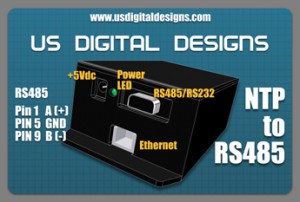
The Problem
A large company that operated a fleet of heavy vehicles wanted to monitor the engine performance on their engines and were especially concerned with pollution compliance.
They wanted to monitor the back-pressure and the temperature of the exhaust system at various points. They wanted to be able to collect data over a period of months at frequent intervals, and be able to down load the large amount of data very rapidly. They also wanted to give the vehicle operator real time warnings if the exhaust system was operating out of desired specifications so pollution penalties could be avoided.
The device should operate on normal vehicle voltages, be able to withstand severe environmental conditions, as well as stand up to the harsh electrical environment found in heavy equipment.
Our Solution
US Digital Designs developed the DT06 engine data logger. The DT06 is constructed using all surface mount technology (SMT) and is contained in an environmentally sealed metal box.
It features EEPROM for non volatile storage of the data, K-type thermocouple input for temperature monitoring, pressure sensor input for exhaust pressure, and several outputs for driver warning lamps. The sample rate of the data is user adjustable and each data point is time stamped via the real time clock. The input voltage can be from 9V to 50Vdc and is protected against spikes and noise.
The entire memory can be dumped in less than 15 seconds through the USB port without opening or removing the enclosure. The USB port is protected with a sealed connector when not in use. The configuration software allows the user to set the real time clock, configure the alarm set points, and vary the sample rate of the data.

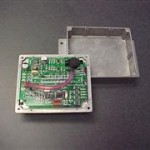
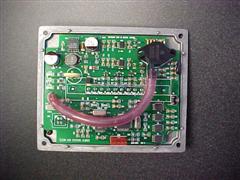
The Solution
A revolutionary new type of DNA amplification chemistry has been developed that requires a constant precise temperature for the reaction (i.e. Isothermal Process) over a very short time period (minutes instead of hours or days). The reaction block needs to hold 16 standard micro vials with the standard 9 mm well spacing. The vials are to be illuminated from below and the florescence be measured from the side of each well.
Our Solution
US Digital Designs developed the Espresso Isothermal Amplifier.
The Espresso stands only 12 inches tall 8 inches wide and weighs under 3 pounds. It is a stand alone Ethernet appliance and can be accessed with a simple web browser on a local network. The Espresso can hold a specified temperature from 25 to 65 degC, plus or minus 0.1 degC. The reaction time can be specified from 30 seconds to 30 minutes, and the sample rate can be configured up to the maximum memory of the unit.
The Espresso provides real time graphing of the data from all 16 wells, as well as a data dump (in standard formats) at the end of the experiment to allow further graphing and analysis with your favorite program. The florescence of each of the 16 wells is measured with an independent photo diode in each well. Each well also contains an isolated filter to eliminate ambient light. The reaction block contains an integrated heater with over temperature protection and a solid state temperature sensor. The block is electro polished to a 10 Ra finish for maximum light transmission.

The Problem
A major aerospace contractor needed to measure the speed of the output shaft of an Auxiliary Power Unit (APU), which is a small jet engine with a geared output. The APU typically powers a three-phase electrical generator. The output shaft had a small magnet embedded within it and the speed was being measured with a Hall effect sensor. The problem was that the signal from the Hall sensor was a sine wave that ranged from 75mv peak to peak at low RPMs to over 50 volts peak to peak at high RPMs. There was an additional problem in that the gearing of the output shaft could vary so the output signal from the Hall sensor could be as high as 32 KHz and as low as 2 KHz.
The customer wanted a digital square wave signal out (TTL) that matched the frequency input, no matter the input voltage or speed. They also wanted a 0-5 volt analog output that was scaled to match the max output speed of the APU output shaft. And for good measure they wanted the whole thing isolated from the input signal with an isolated raw signal fed back out that they could monitor.
No existing off-the-shelf signal conditioner could handle the job, so the client turned to US Digital Designs for a creative solution.
Our Solution
US Digital Designs developed the DT03C Isolated Frequency to Voltage Converter.
This signal conditioner is mounted in a DIN rail mount package measuring aprox 5 x 4 x 1 inches. The DT03C accepts the Hall sensor signal and outputs an isolated TTL square wave that precisely matches the input sine wave regardless of the voltage or frequency.
The DT03C also measures the output frequency and produces a 0-5 volt analog signal that is scaled to match the desired max input frequency. The input frequency is dip switch selectable in 5 ranges from 2 KHz max to 32 KHz max. The original raw signal is also isolated and fed back out two isolated terminal for monitoring.
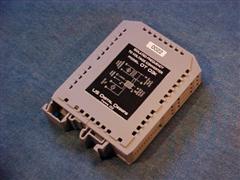
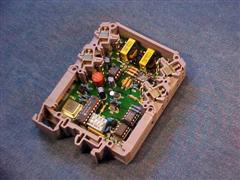
The Problem
A major aerospace company wanted to automate their testing of APU (Auxiliary Power Unit). The APU is a small gas turbine (jet) engine connected to a 3 phase generator. This generator/APU combination is typically used to power all of the electronics in a modern jet aircraft.
The generator is connected to a “load bank,” which is a series of power resistors which can be switched in and out of the circuit to simulate various loads from one to several hundred kilowatts. In the past the loads had to be manually switched on and off which made testing time consuming and allowed for the possibliy of an improper load being applied to the generator. In the event of a fault condition the load bank would need to be disconnected in a safe sequence.
Our Solution
US Digital Designs designed the DT04a Load Bank Controller. It was specifically designed as an intelligent interface between the existing gas turbine test stand control system (running LabView software), a 3 phase power meter with serial output and the load bank itself. Based upon load commands from the labView control systems, the DT04a would turn on load resistors in a logic manner to achieve the desired load. The actual load as read from the power meter was used to precisely match the desired load. Variations in engine speed and generator output were automatically and continuously adjusted for. The desired load could be changed at any point from the control software.
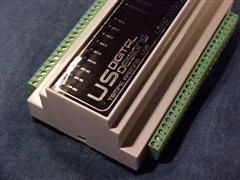
Sergeant V6 Gas Cabinet Controller
The Sergeant V6 Gas Cabinet Controller is designed to monitor, control and maintain safe operation of manual gas delivery cabinets. The Sergeant V6 will provide panel status, audible alarms and visual indication of alarm conditions to allow for either safe operator manual panel shutdown or safe automatic panel shutdown.
The Sergeant V6 has auto-change mode built in as a standard feature. When auto-change mode is enabled, the Sergeant V6 Controller will automatically change to a secondary gas supply cylinder in the event of a low pressure/weight condition on the primary cylinder.
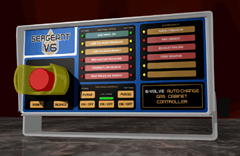
Corporal Auto Change Over Controller
The Corporal Auto Change Over Controller is designed to automatically switch between two cylinders of inert gas. Front panel controls and innovative graphic interface allow you to determine at a glance which cylinder is online and to control the auto change operation.
The Corporal Auto Change Controller will provide panel status, audible alarms and visual indication of alarm conditions. The flexible design and programming allows the Corporal Auto Change Controller to be used on just about any manufacturer’s gas system.
